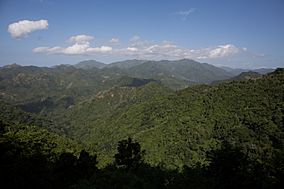Cuchillas del Toa facts for kids
Quick facts for kids Cuchillas del Toa |
|
|---|---|
|
IUCN Category IV (Habitat/Species Management Area)
|
|

View from La Farola to the Cuchillas de Toa
|
|
| Location | |
| Nearest city | Baracoa |
| Area | 2,023.54 km2 (781.29 sq mi) |
| Established | 1987 |
| Governing body | El Ministerio de Ciencia, Tecnología y Medio Ambiente (CITMA) |
Cuchillas del Toa (which means "Ridges of Toa" in English) is a very special natural area in Cuba. It is officially recognized as a Biosphere Reserve. This important place is found in the eastern part of Cuba. Most of it is in the Guantánamo Province, but it also reaches north into the Holguín Province.
The reserve gets its name from the Toa River. This river flows for about 118 kilometers (73 miles) through the area. It eventually reaches the Atlantic Ocean near the town of Baracoa.
Contents
What is Cuchillas del Toa?
This reserve covers a huge area of land and sea. It spans about 2,083 square kilometers (804 square miles). A small part of this, about 60 square kilometers (23 square miles), is a marine area in the ocean.
A Place Full of Life
Cuchillas del Toa is known as one of the most important places for biodiversity in Cuba. Biodiversity means there are many different kinds of plants and animals living there. It also has a lot of endemism. This means many species are found only in this specific area and nowhere else in the world.
The reserve has many different types of environments:
- Pine forests
- Cloud forests (where clouds often cover the trees)
- Dry scrublands
- Coastal areas with mangrove trees and coral reefs
Amazing Natural Features
One cool feature is the karstic system of the Great Cave of Moa Headlands. A karstic system is a landscape shaped by water dissolving rock, creating caves and sinkholes. This cave system is one of Cuba's five natural monuments. It is also one of the largest cave systems in eastern Cuba.
The reserve also protects tropical wet forests. These are lush, green forests that get a lot of rain. It also protects coastal and marine ecosystems. Inside the reserve, you will find the Alejandro de Humboldt National Park. Other famous spots include:
- El Yunque table mountain, which looks like an anvil.
- The Infierno Creek with a 300-meter (984-foot) waterfall.
- The Great Cave of Moa (Gran Caverna de Moa).
- The Bay of Taco, located north of Baracoa.
Unique Plants and Animals
Cuchillas del Toa is home to 928 species that are found only here. This includes ancient plant types like Podocarpus and Dracaena.
Many rare and endangered animals live here too:
- The Cuban ivory-billed woodpecker (Campephilus principalis bairdii), which is highly endangered.
- The Cuban kite (Chondrohierax wilsoni).
- The Cuban solenodon (Solenodon cubanus), also known as the almiquí. This is a very unique mammal.
- Some of the world's smallest mammal species also live in the reserve.
Other protected species include:
- The Cuban trogon (Priotelus temnurus), which is Cuba's national bird.
- Gundlach's hawk (Accipiter gundlachi).
- The Cuban green woodpecker (Xiphidiopicus percussus).
People and History
About 18,300 people live in the areas around the reserve. They live in 498 communities. These communities are involved in different activities like:
- Forestry (managing forests)
- Traditional farming (growing coffee, coconut, and cacao)
- Raising cattle
- Ecotourism (tourism that helps protect nature)
Some people also work in mining for metals like nickel, chromium, iron, and cobalt. These activities can sometimes put pressure on the natural environment. Protecting the reserve while supporting local communities is an important challenge.
This biosphere reserve also has an interesting history. In the 18th and 19th centuries, people who had escaped slavery found safety and freedom in this region. They were known as Cimmarones.
Cuchillas del Toa is connected with the Montes Azules Biosphere Reserve in Chiapas, Mexico. They are like "sister" reserves because they have similar environments and ways of managing their natural resources.
Protecting the Reserve
The Cuchillas del Toa reserve is classified as an IUCN Managed Resource Protected Area. This means it is managed to protect nature while also allowing some sustainable use of resources.
The total area of the reserve is about 2,023.54 square kilometers (781 square miles). Its most protected part is the Alejandro de Humboldt National Park. This park is divided into four smaller areas: Cupeyal del Norte, Ojito de Agua, la Melba, and Baracoa.
Cuchillas del Toa was officially recognized as a UNESCO Biosphere Reserve in 1987. This international recognition helps protect its unique natural treasures.
Different Protected Zones
The reserve has different zones with various levels of protection. These zones are further divided into other protected areas. Examples include:
- The proposed Ecological Reserve Quivijan-Duaba-Yunque de Baracoa.
- The Flora Managed Reserve of Pico Galan (Galan Peak).
See also
 In Spanish: Cuchillas del Toa para niños
In Spanish: Cuchillas del Toa para niños


